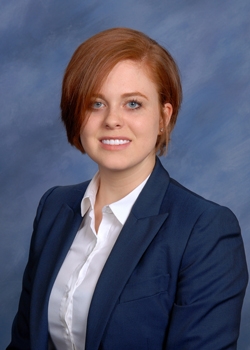
An article written by Wayne State University School of Medicine fourth-year medical student Megan Baker chronicling a heart failure case study was published Aug. 28 in the journal JAMA Internal Medicine.
Baker wrote "Cardiac Resynchronization Therapy - Does One Size Fit All?" with Lakshmi Swaminathan, M.D., M.H.S.A., and David Weidendorf, M.D., Internal Medicine physicians at Beaumont Hospital in Dearborn, Mich.
In it, they describe the case of a frail woman in her 90s who experienced fatal complications after implantation of a cardiac resynchronization pacemaker, or CRT-P, and point out the possible harms of placing a device in a high-risk patient with less than clear indications. The patient had nonischemic cardiomyopathy, atrial fibrillation and heart failure, among other ailments, including a history of bladder cancer.
The case, they wrote, underscores the need for "considering frailty, comorbidities, life expectancy and quality-of-life expectations in determining appropriateness and timing of CRT in the management of heart failure. Furthermore, it emphasizes the usefulness of interdisciplinary patient-centered discussions of relative risks and benefits in guiding challenging procedure decisions, especially when invasive device therapies are recommended."
The article spurred invited commentary from the journal in the editorial "Toward Improving Patient Safety."
Baker was part of the Internal Medicine team when the patient returned to the hospital with what was discovered to be hemothorax. "The complications suffered by this woman struck the whole team, and it led me to read about the guidelines for CRT and consider their role in the delivery of patient-centered care," she said.
Hemothorax is a collection of blood in the space between the chest wall and the lung cavity. The patient also returned with inflammation of the colon in the form of Clostridium difficile colitis, or C. diff. She died six weeks after undergoing thoracentesis, a procedure for hemothorax in which a needle is inserted into the area to remove excess fluid, usually helping the patient breathe better.
"This case was at the start of my third year and marked the beginning of my interest in quality improvement, which has grown over the past year working in the clinical setting," Baker said. "I was very excited to have it accepted, and am happy and relieved to have it published."
Baker, a member of the Class of 2018, is now applying to Internal Medicine residency programs. She is a native of Saginaw, Mich.
"Megan is a superstar. She has tremendous initiative. She is very interested in improving quality of care and is currently involved in several projects," said Internal Medicine Professor and Vice Chair for Education Diane Levine, M.D., F.A.C.P. "I hope she considers staying and training with us."